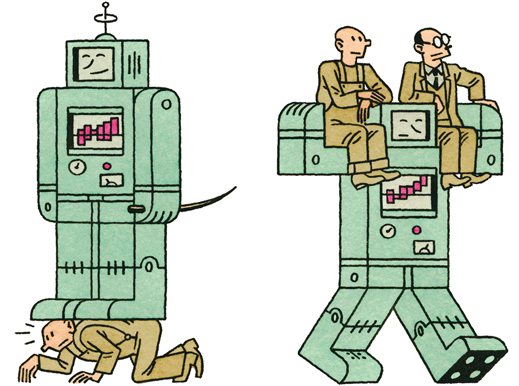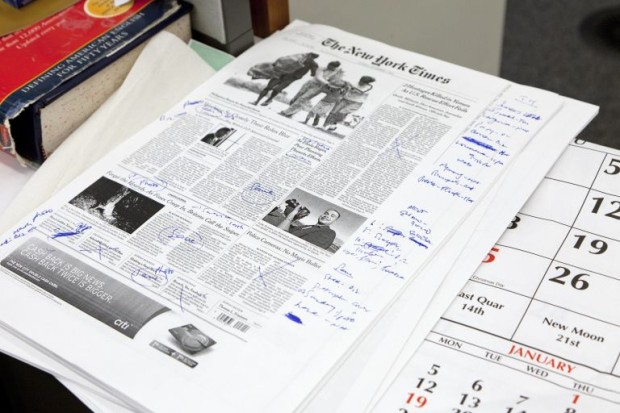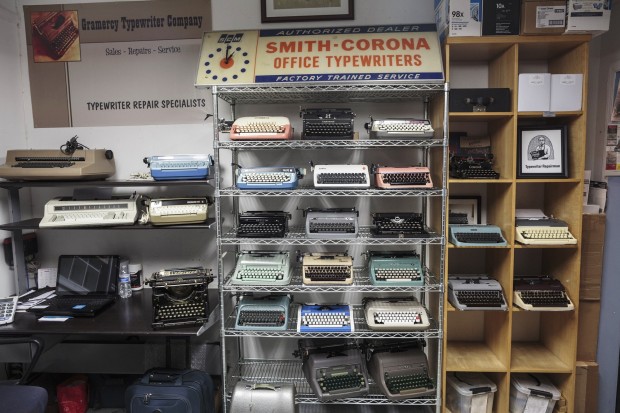
Tom Gauld for the New Scientist.
By weird coincidence this tribute to Ingmar Bergman from the 1981 TV special “The Muppets Go to the Movies” with Beaker as Death also popped up in my timeline this week.
Comments closedBooks, Design and Culture

Tom Gauld for the New Scientist.
By weird coincidence this tribute to Ingmar Bergman from the 1981 TV special “The Muppets Go to the Movies” with Beaker as Death also popped up in my timeline this week.
Comments closed
Writing at the MIT Technology Review, David Rotman looks at the impact of automation and digital technology on jobs with reference to a number of recent books related to the subject including Rise of the Robots: Technology and the Threat of a Jobless Future by Martin Ford, The Great Divide by Joseph Stiglitz, and The Second Machine Age by Erik Brynjolfsson and Andrew McAfee. But if you find that all too depressing to contemplate — and who doesn’t? — you can at least enjoy the wonderful Joost Swarte illustrations that accompany article …

My ‘longreads’ to-read list is as bad, if not worse, than the pile of books I have to read right now, so it’s taken me until today to get to that very, very long New Yorker profile of Jonathan Ive, the senior vice-president of design at Apple.
Unfortunately, the whole thing is a bit disappointing and, I thought, even a little sad. By the end, Ive remains an enigma. What lingers is his famous friends, love of bland luxury brands, and just how remarkably wealthy he is (writer Ian Parker reminds you several times that Ive owns a private jet).
It seems Ive is either depressingly shallow or, more likely, these superficial things are all that he is willing to reveal about himself, which is depressing too in its own way. Ive is, no doubt, just politely protecting his privacy, but he comes across as peevish and sadly unlikeable, which is a shame. Or maybe I’m just not interested enough in industrial design and luxury brands, or Apple if it comes to that.
The article does, however, give me an excuse to post this blistering 15 minute video of NYU Stern marketing professor Scott Galloway talking a mile-a-minute about Apple, Amazon, Facebook and Google. I’m sure he’s wrong about a lot of things, but not only does he talk about Apple’s transition from tech company to luxury brand, he also offers some of the most cogent insights into the current problems facing Amazon I’ve heard in a while:
Interestingly, Ian Parker says in his New Yorker article that watch manufacturers are not worried about Apple stepping into the market. Galloway says they should be. I guess we’ll see who is right.
Comments closed
In a fascinating piece for Popular Mechanics, Reeves Wiedeman looks at how the New York Times gets made in 2015. It’s interesting how their graphics department has evolved in the past few years:
The Times employs approximately 1,300 journalists, a classification that now includes much more than writers, editors, and photographers. There are videographers and developer–journalists and graphic designers, who insist that you not call them graphic designers. Every section of the paper has been affected by the Internet, but the graphics department is hardly recognizable from the days not long ago when, to accompany a story about Borneo, for example, it would simply produce a small black-and-white map of Borneo. [Graphics editor] Duenes’s desk still produces traditional newspaper graphics, but it also now employs thirty-five people who have expertise in statistics, programming, cartography, 3D modeling, motion graphics, audio production, or video editing. At the department’s two long desks, designer Haeyoun Park combs through data on the racial breakdown of police forces—a story the graphics team reported without any instigation from print reporters—while nearby Matt Bloch is updating the paper’s digital hurricane tracker… A breaking-news event might require eight members of Duenes’s team, who are otherwise free to focus on the kind of in-depth reporting for which the Times‘ print reporters are generally known. Last August a graphics editor who had been tracking police data for four years discovered that the New York Police Department had more or less ended its controversial stop-and-frisk policy, which some critics had described as racial profiling. This was news to the reporters on the Metro desk, and the editor there assigned a story to go along with the graphics department’s analysis.
The story, and the graphic, ran on the front page.
I also particularly liked the stuff about their R & D Lab:
1 CommentThe R&D Lab opened nine years ago with the goal of looking three to five years into the future. (TheTimes declined to say how much it cost to build.) Marc Frons, the company’s CIO says he has no idea how people will interact with theTimes in ten years, “whether it’s on your wrist, or your forehead, or you take a pill, or it’s a holographic contact lens, or a head-up display in your vehicle—or on your mirror in your bathroom.” The lab explored E Ink before the Kindle even existed, was responsible for delivering the earliest versions of the paper’s mobile news alerts, and helped the Times become the first publisher with an application on Google Glass. One of the lab’s researchers recently designed a brooch programmed to light up whenever a topic is mentioned that matches something the wearer read about online that day. What good would that do, exactly? Boggie answers with enthusiasm, “We don’t know yet!”
Related to yesterday’s post on Gramercy Typewriter Co. in New York, here’s a short film about U.S. Office Machines, one of the last remaining typewriter repair shops in Los Angeles:
(Thanks Sam!)
1 Comment
At Medium, Mary Pilon profiles Paul Schweitzer of Gramercy Typewriter Co. — a father-and-son business in the Flatiron District of New York that will still repair your typewriter:
“Computers are being updated all the time,” he said, rolling his eyes at a PC laptop his son keeps in the corner. “Your computer becomes obsolete in a very short amount of time. It’s slow. It doesn’t have enough memory. A new model comes out. A printer won’t work with it anymore. That Underwood over there” — he points at a gleaming, black machine fit for James Joyce — “it’s 100 years old. What computer is going to last 100 years?”
Schweitzer was also the subject of this 2012 documentary short by Prospect Productions:
And if you can’t get enough of this stuff, I was reminded of this 2010 Wired article about the last generation of typewriter repairmen in California.
3 Comments